Comparative Analysis of Two Types of Combined Power-Over-Fiber and Radio-Over-Fiber Systems Using Raman Amplification for Different Link Lengths †
Abstract
1. Introduction
2. RoF and PoF Receiving Analog RF Link
3. Experimental Measurement Procedure and Results
3.1. Experimental Measurement Procedure
- RF Power Gain Measurement
- Noise Figure Measurement
- Spurious-free dynamic range measurement
3.2. Theoretical Procedure
- RF Power Gain Theory
- Noise Figure Theory
- Spurious-free dynamic range theory
4. Optical and Radio Frequency Measurement Analysis
Optical Measurements Analysis
- Raman amplification
- Power over Fiber Analysis
- Radio frequency measurement analysis
5. Conclusions
Author Contributions
Funding
Institutional Review Board Statement
Informed Consent Statement
Data Availability Statement
Conflicts of Interest
Abbreviations
| ASE | Amplified Spontaneous Emission |
| BER | Bit Error Rate |
| OC1 | Optical Circulator 1 |
| OC2 | Optical Circulator 2 |
| EDFA | Erbium-Doped Fiber Amplifier |
| EVM | Error Vector Magnitude |
| HPLS | High Power Laser Source |
| ISO | Isolator |
| IM/DD | Intensity Modulation and Direct Detection |
| MMF | Multimode Fibers |
| MZM | Mach–Zehnder Modulator |
| NF | Noise Figure |
| PD | Photodetector |
| PPC | Photovoltaic Power Converter |
| PoF | Power over Fiber |
| PON | Passive Optical Networks |
| PSD | Power Spectral Density |
| RIN | Relative Intensity Noise |
| RoF | Radio over Fiber |
| SMF | Single-mode fiber |
| SFDR | Spurious-Free Dynamic Range |
| SRS | Stimulate Raman Scattering |
| TLS | Tunable Laser Source |
| TOF1 | Tunable Optical Filter 1 |
| TOF2 | Tunable Optical Filters 2 |
| WDM1 | Wavelength Division Multiplexer 1 |
| WDM2 | Wavelength Division Multiplexer 2 |
References
- Matsuura, M. Recent Advancement in Power-over-Fiber Technologies. Photonics 2021, 8, 335. [Google Scholar] [CrossRef]
- Urick, J.; Jason, D.M.; Keith, J.W. Fundamentals of Microwave Photonics; John Wiley & Sons, Inc.: Hoboken, NJ, USA, 2015. [Google Scholar]
- Altuna, R.; López-Cardona, J.D.; Al-Zubaidi, F.M.A.; Montero, D.S.; Vázquez, C. Power-Over-Fiber Impact and Chromatic-Induced Power Fading on 5G NR Signals in Analog RoF. J. Light. Technol. 2022, 40, 6976–6983. [Google Scholar] [CrossRef]
- Diouf, C.; Quintard, V.; Ghisa, L.; Guegan, M.; Pérennou, A.; Gautier, L. Design. Characterization, and Test of a Versatile Single-Mode Power-Over-Fiber and Communication System for Seafloor Observatories. IEEE-JOE 2020, 45, 656–664. [Google Scholar] [CrossRef]
- Headley, C.; Agrawal, G.P. Raman Amplification in Fiber Optical Communication Systems; Elsevier: Burlington, VT, USA, 2005. [Google Scholar]
- Matsuura, M.; Ikukawa, A.; Kuboki, H.; Kawamura, Y. Investigation of Crosstalk between Data Signals and Feed Light in Power-over-Fiber. Photonics 2022, 9, 369. [Google Scholar] [CrossRef]
- Rahamn, M.T.; Nur-a-Alam, M.; Ahmed, R.; Hossain, K.; Haque, A. Performance Analysis of WDM-PON Radio over Fiber Network System Using Multi-Pump Raman Amplifier; ITNAC: Sydney, Australia, 2021; pp. 204–209. [Google Scholar] [CrossRef]
- Varlamov, A.; Agruzov, P.; Parfenov, M.; Tronev, A.; Ilichev, I.; Usikova, A.; Shamrai, A. Power-over-Fiber with Simultaneous Transmission of Optical Carrier for a High Frequency Analog Signal over Standard Single-Mode Fiber. Photonics 2023, 10, 17. [Google Scholar] [CrossRef]
- Yamagata, Y.; Kumagai, T.; Sai, Y.; Uchida, Y.; Imai, K. A sensor powered by pulsed light (for gas density of GIS). In Proceedings of the TRANSDUCERS’91: 1991 International Conference on Solid-State Sensors and Actuators, San Francisco, CA, USA, 24–27 June 1991; pp. 824–827. [Google Scholar] [CrossRef]
- De Nazaré, F.V.B.; Werneck, M.M. Temperature and current monitoring system for transmission lines using power-over-fiber technology. In Proceedings of the 2010 IEEE Instrumentation & Measurement Technology Conference Proceedings, Austin, TX, USA, 3–6 May 2010; pp. 779–784. [Google Scholar] [CrossRef]
- Rosolem, J.B.; Tomiyama, E.K.; Danilo, C.D.; Bassan, F.R.; Penze, R.S.; Leonardi, A.A.; Floridia, C.; Fracarolli, J.P.V.; Teixeira, R.M. A fiber optic powered sensor designed for partial discharges monitoring on high voltage bushings. In Proceedings of the 2015 SBMO/IEEE IMOC, Porto de Galinhas, Brazil, 3–6 November 2015; pp. 1–5. [Google Scholar] [CrossRef]
- Al-Zubaidi, F.M.A.; López Cardona, J.D.; Montero, D.S.; Vázquez, C. Optically Powered Radio-Over-Fiber Systems in Support of 5G Cellular Networks and IoT. J. Light. Technol. 2021, 39, 4262–4269. [Google Scholar] [CrossRef]
- Hamie, R.; Ghisa, L.; Pérennou, A.; Quintard, V.; Guegan, M.; Fadlallah, M.; Hamié, A. Experimental characterization of an improved power-over-fiber system for seafloor applications. Eng. Res. Express 2019, 1, 015011. [Google Scholar] [CrossRef]
- Al-Zubaidi, F.M.A.; Montero, D.S.; Pinzón, P.J.; Vázquez, C. Performance Evaluation of High Data Rate Transmission and Optically Powered IoT Ecosystem over SI-POF for Smart Home Applications. In Proceedings of the 23rd International Conference on Transparent Optical Networks (ICTON), Bucharest, Romania, 2–6 July 2023; pp. 1–4. [Google Scholar] [CrossRef]
- Wang, J.; Li, Q.; Yah, J.; Ding, Y.; Lu, Y.; Zhang, Y. Power-over-fiber technique based sensing system for the Internet of things. In Proceedings of the 15th International Conference on Optical Communications and Networks (ICOCN), Hangzhou, China, 24–27 September 2016; pp. 1–3. [Google Scholar] [CrossRef]
- Guo, Z.; Liu, J.; Shimamoto, S. Radio and Power over Fiber System for 4K/8K Satellite Antenna. In Proceedings of the 2020 IEEE International Conference on Communication, Networks and Satellite (Comnetsat), Batam, Indonesia, 17–18 December 2020; pp. 154–158. [Google Scholar] [CrossRef]
- Carpenter, A.; Lawrence, J.A.; Mason, P.J.; Ghail, R.; Agar, S. Drone SAR Imaging for Monitoring an Active Landslide Adjacent to the M25 at Flint Hall Farm. Remote Sens. 2024, 16, 3874. [Google Scholar] [CrossRef]
- Tariq, M.H.; Zhang, S.; Masouros, C.; Papadias, C.B. Energy Efficient Multi-Active/Multi-Passive Antenna Arrays for Portable Access Points. Micromachines 2024, 15, 1351. [Google Scholar] [CrossRef] [PubMed]
- Aouladhadj, D.; Kpre, E.; Deniau, V.; Kharchouf, A.; Gransart, C.; Gaquière, C. Drone Detection and Tracking Using RF Identification Signals. Sensors 2023, 23, 7650. [Google Scholar] [CrossRef] [PubMed]
- Souza, R.H.; Kiohara, P.; Ghisa, L.; Guegan, M.; Quintard, V.; Coutinho, O.L. Analog Response in Optically Powered Radio-Over-Fiber Links with Distributed Amplification in Single-Mode Fibers. JLT 2023, 41, 7083–7091. [Google Scholar] [CrossRef]
- Agrawal, G.P. Nonlinear Fiber Optics, 3rd ed.; Academic Press: San Diego, CA, USA, 2001. [Google Scholar]
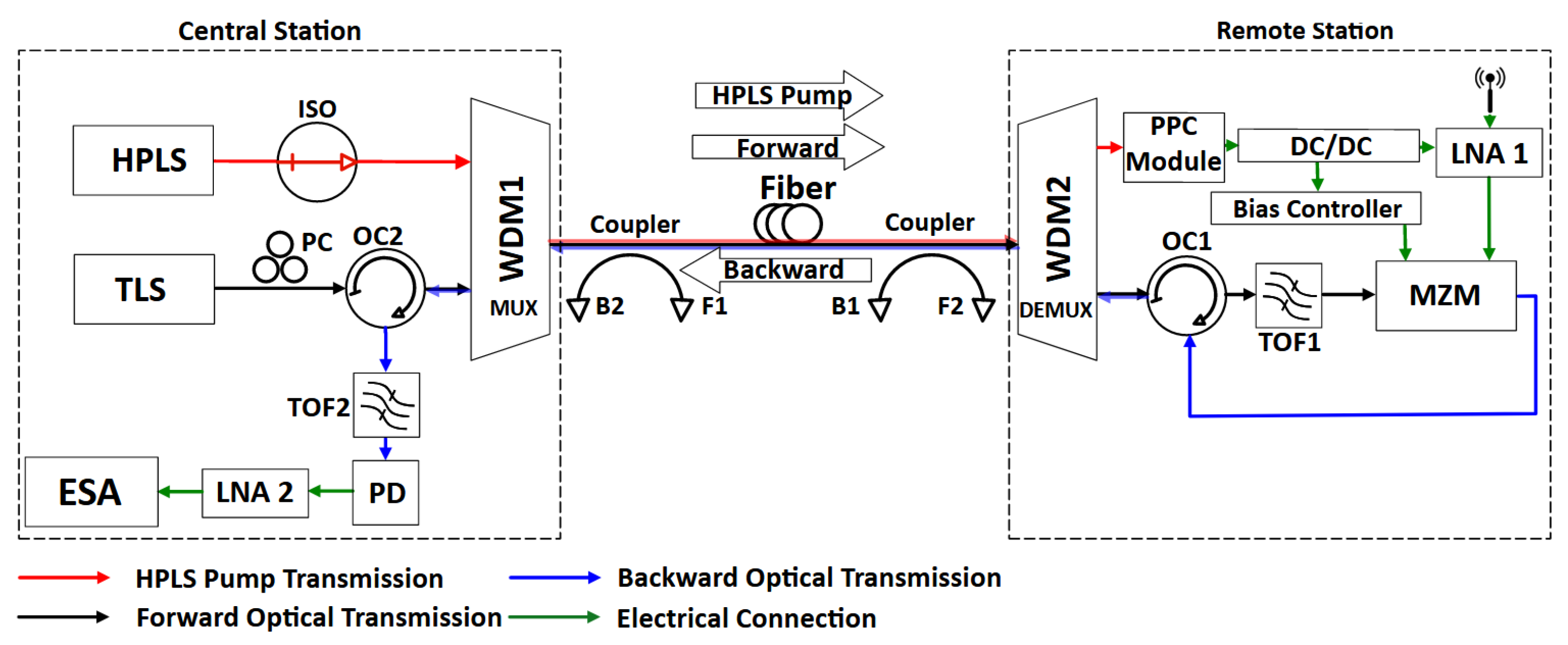
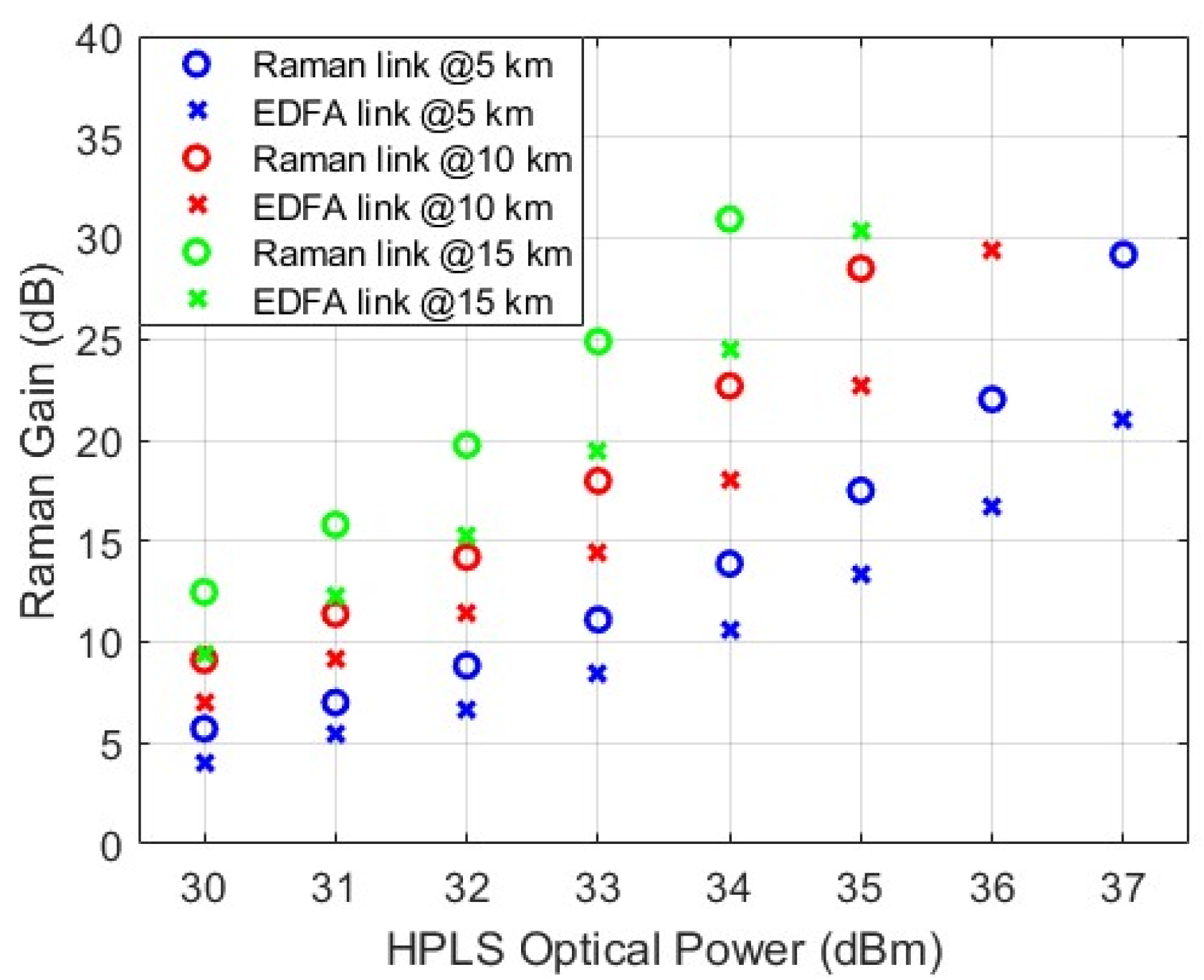

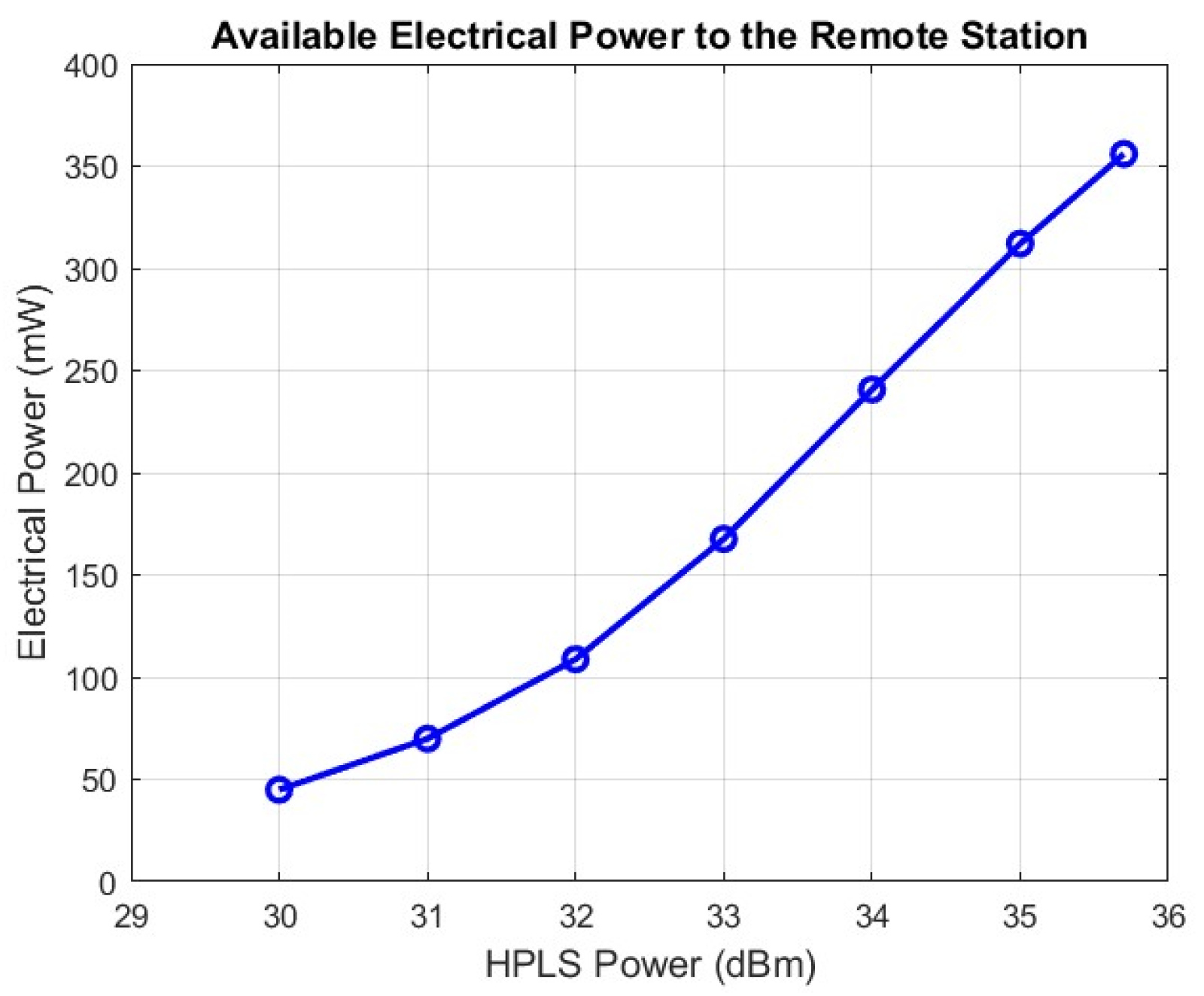
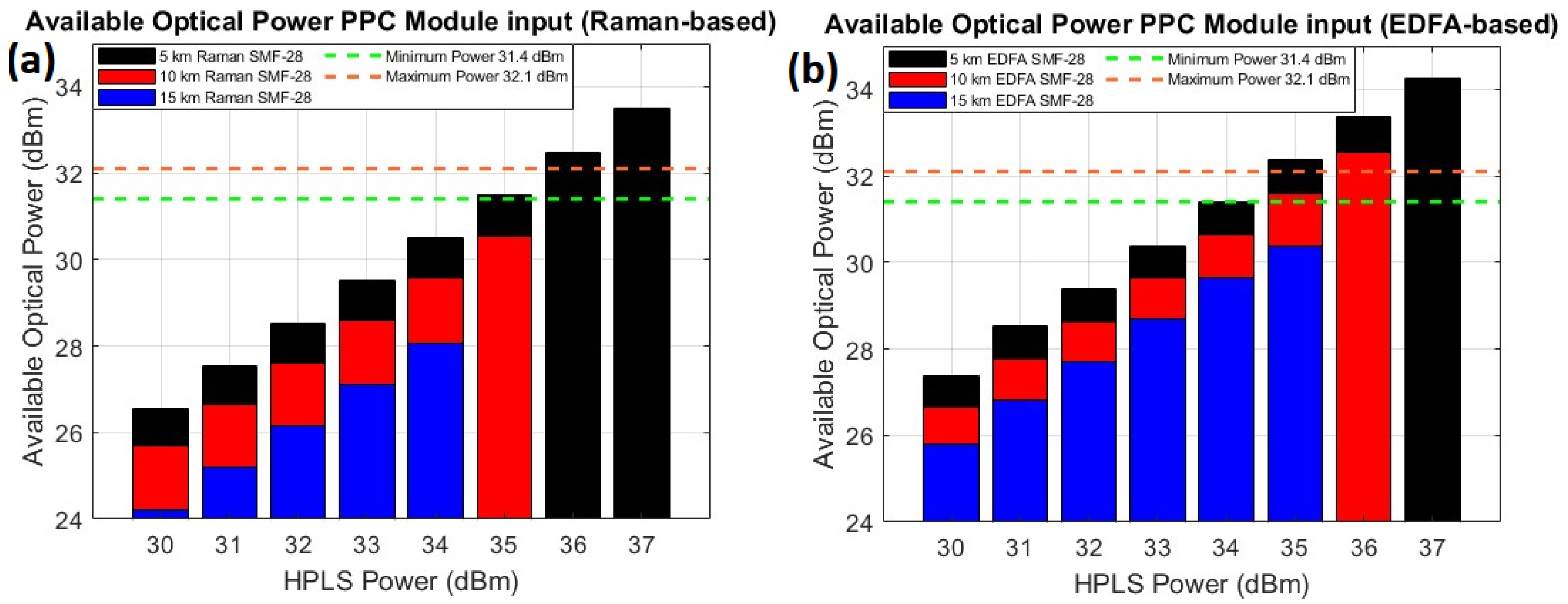
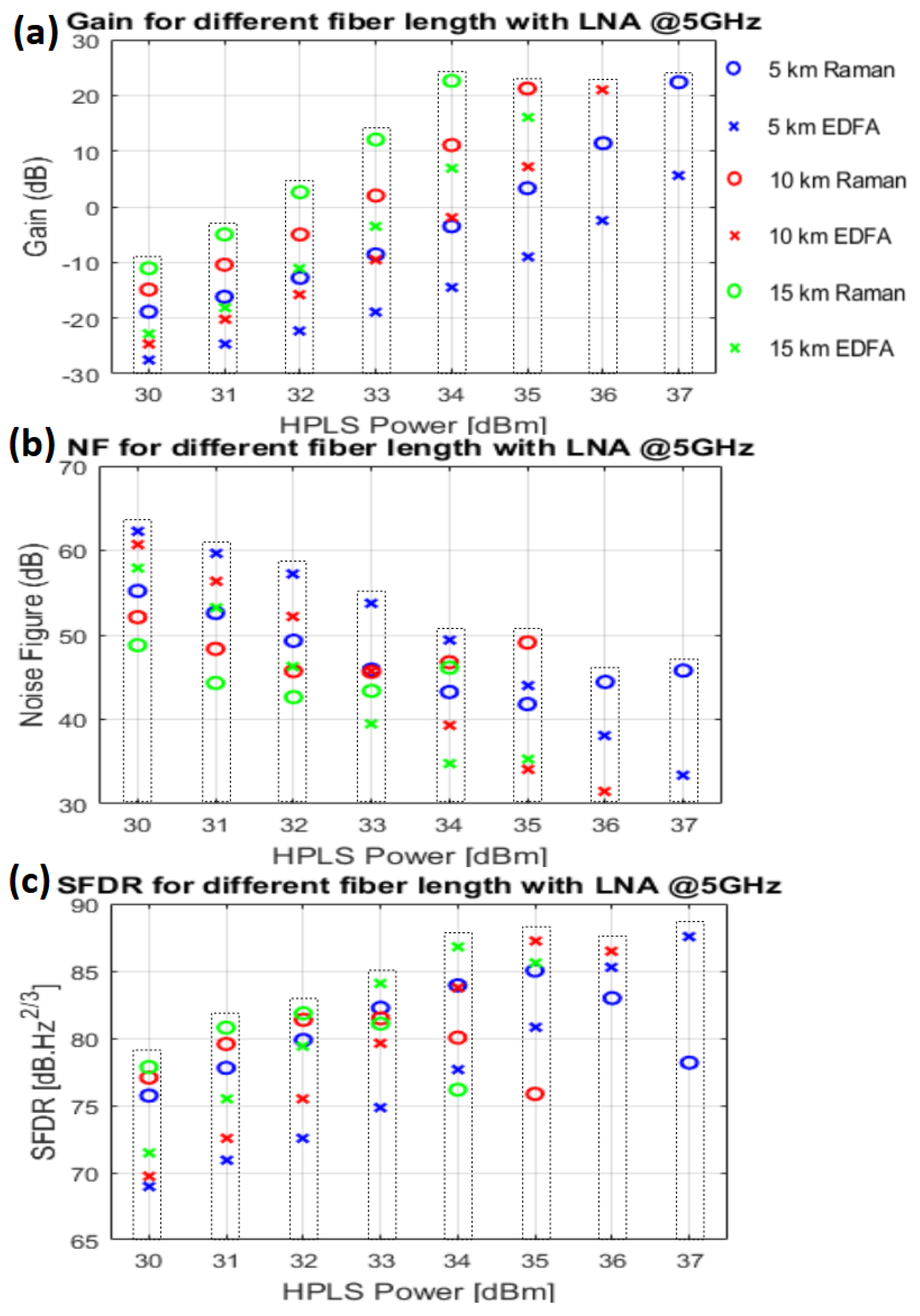
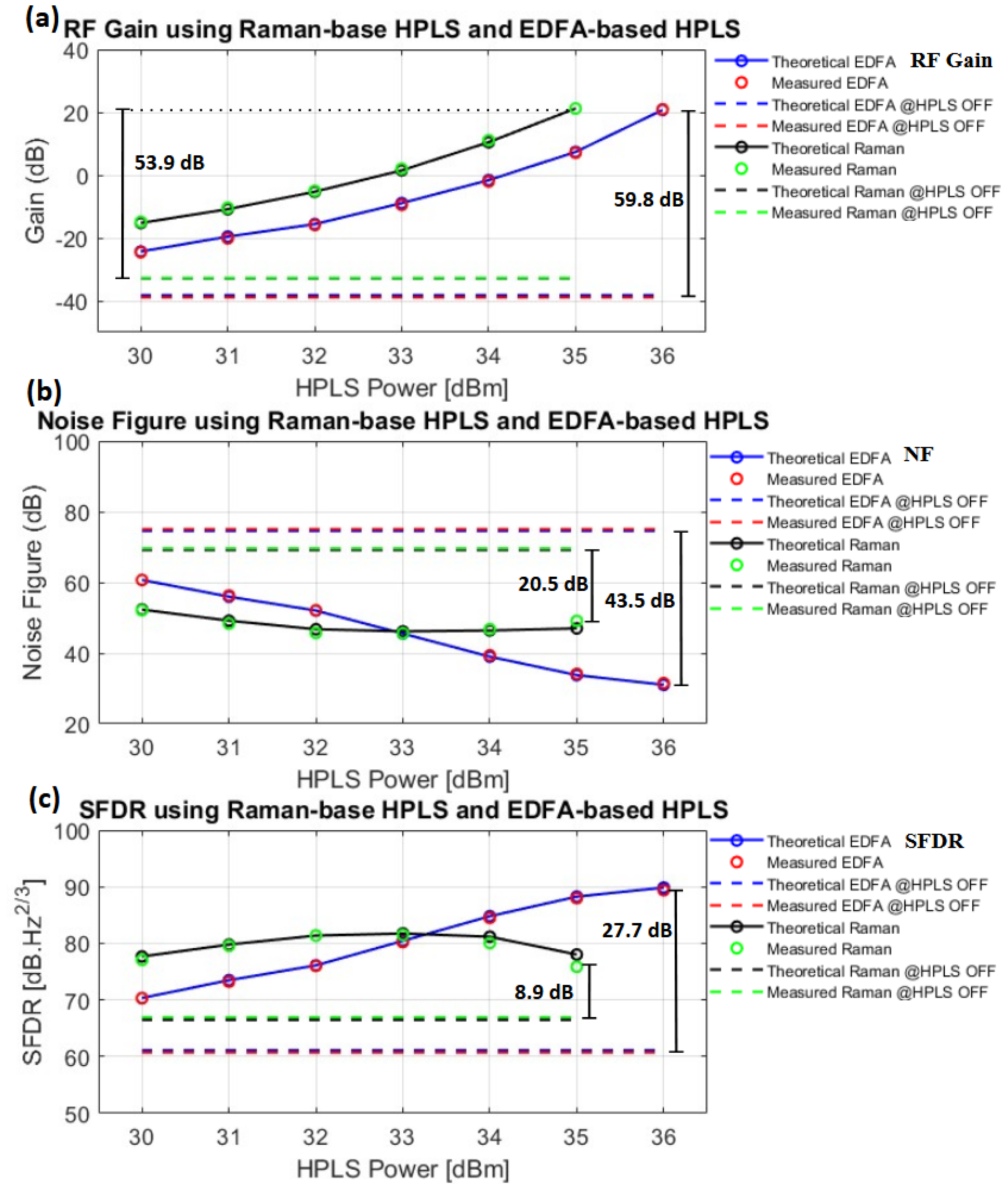
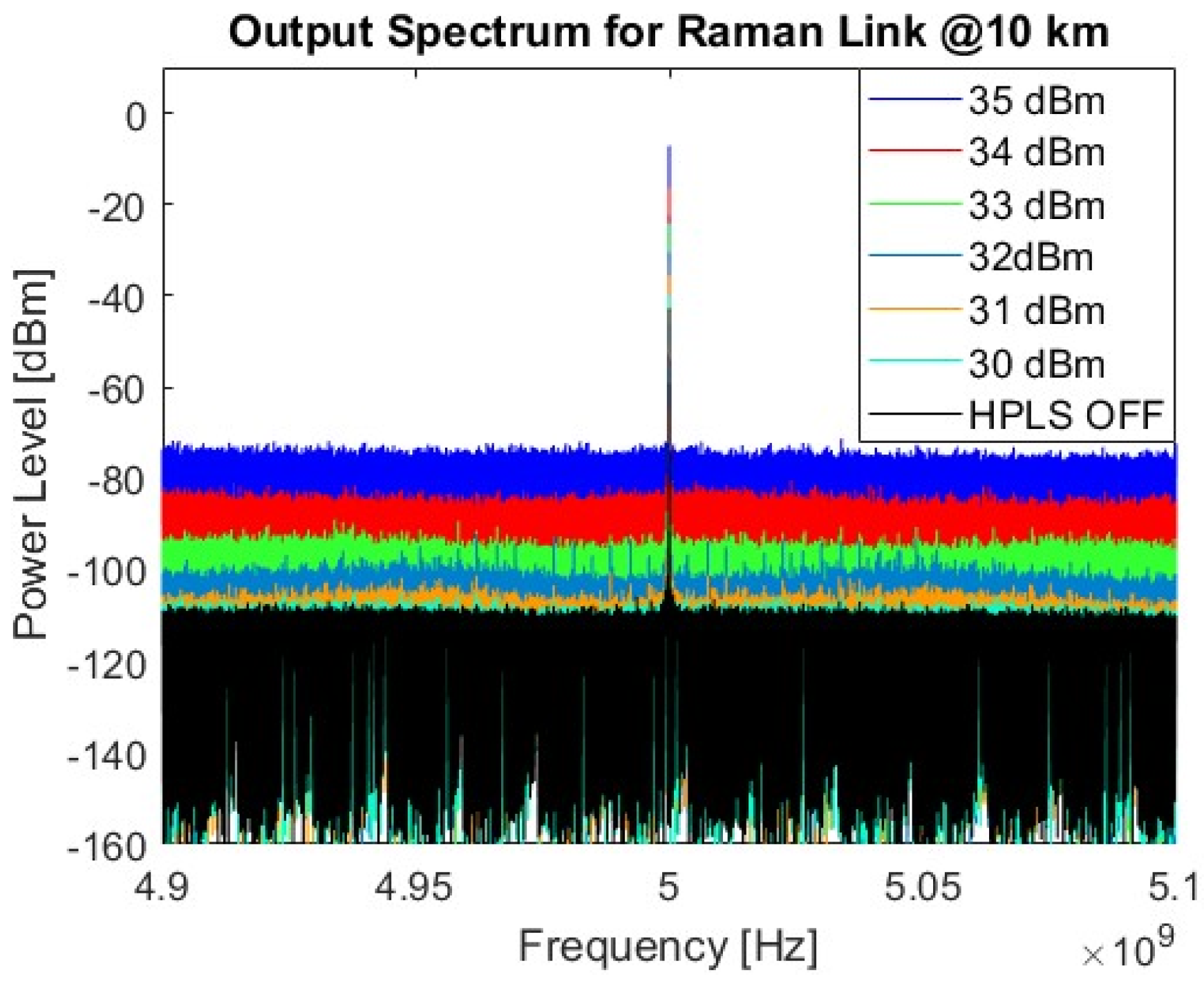
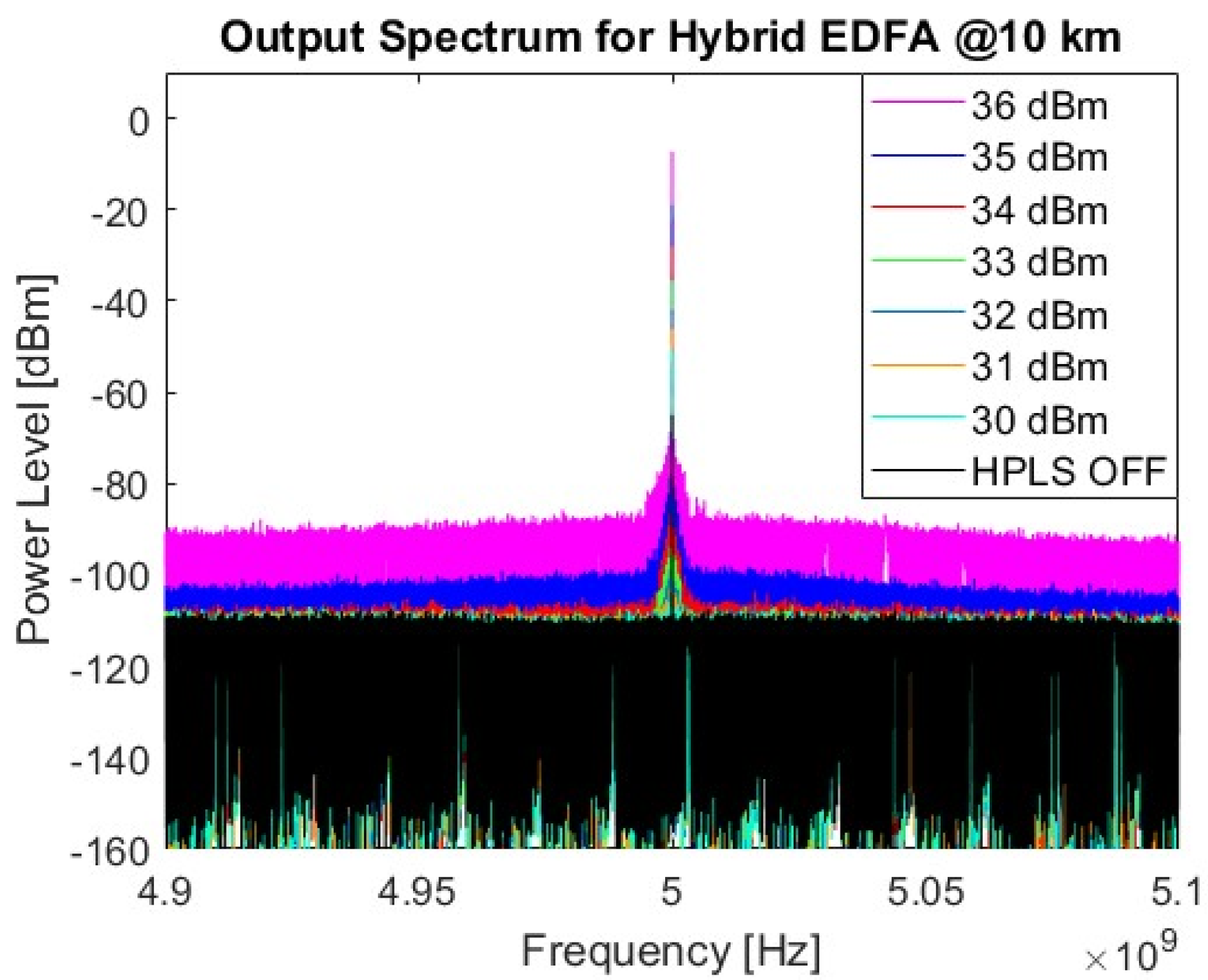
| Fiber Length | 5 km | 10 km | 15 km | |||
|---|---|---|---|---|---|---|
| HPLS | Raman | EDFA | Raman | EDFA | Raman | EDFA |
| (dB) | 41.8 | 33.3 | 45.6 | 31 | 42.6 | 34.7 |
| (dB) | 3.3 | 5.5 | 2 | 21.3 | 2.6 | 8.8 |
| () | 85 | 87.5 | 81.5 | 86.4 | 81.8 | 86.8 |
| (dBm) | 35 | 37 | 33 | 36 | 32 | 33.4 |
| (dBm) | 31.5 | 34.3 | 28.4 | 32.6 | 26.2 | 29.6 |
Disclaimer/Publisher’s Note: The statements, opinions and data contained in all publications are solely those of the individual author(s) and contributor(s) and not of MDPI and/or the editor(s). MDPI and/or the editor(s) disclaim responsibility for any injury to people or property resulting from any ideas, methods, instructions or products referred to in the content. |
© 2025 by the authors. Licensee MDPI, Basel, Switzerland. This article is an open access article distributed under the terms and conditions of the Creative Commons Attribution (CC BY) license (https://creativecommons.org/licenses/by/4.0/).
Share and Cite
Kiohara, P.; Souza, R.H.; Quintard, V.; Guegan, M.; Ghisa, L.; Pérennou, A.; Coutinho, O.L. Comparative Analysis of Two Types of Combined Power-Over-Fiber and Radio-Over-Fiber Systems Using Raman Amplification for Different Link Lengths. Sensors 2025, 25, 4159. https://doi.org/10.3390/s25134159
Kiohara P, Souza RH, Quintard V, Guegan M, Ghisa L, Pérennou A, Coutinho OL. Comparative Analysis of Two Types of Combined Power-Over-Fiber and Radio-Over-Fiber Systems Using Raman Amplification for Different Link Lengths. Sensors. 2025; 25(13):4159. https://doi.org/10.3390/s25134159
Chicago/Turabian StyleKiohara, Paulo, Romildo H. Souza, Véronique Quintard, Mikael Guegan, Laura Ghisa, André Pérennou, and Olympio L. Coutinho. 2025. "Comparative Analysis of Two Types of Combined Power-Over-Fiber and Radio-Over-Fiber Systems Using Raman Amplification for Different Link Lengths" Sensors 25, no. 13: 4159. https://doi.org/10.3390/s25134159
APA StyleKiohara, P., Souza, R. H., Quintard, V., Guegan, M., Ghisa, L., Pérennou, A., & Coutinho, O. L. (2025). Comparative Analysis of Two Types of Combined Power-Over-Fiber and Radio-Over-Fiber Systems Using Raman Amplification for Different Link Lengths. Sensors, 25(13), 4159. https://doi.org/10.3390/s25134159






